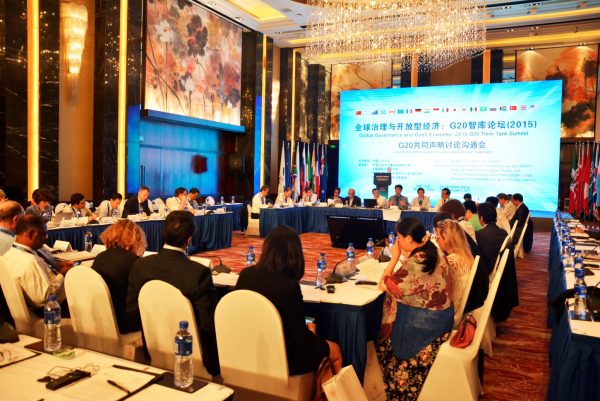China’s G20 presidency has been long-awaited. China sees the G20 as the world’s ‘foremost international economic cooperative mechanism’, unique for giving developing countries an equal voice at the table. Now is China’s time to step up to the plate. One thing was clear from G20 meetings in Beijing and Shanghai: there is no shortage of ideas and risks for China’s upcoming presidency. These tend to fall into three categories: growth, governance and leadership.
On growth, there is an increasing concern that the G20 will fail to deliver on its promise to lift G20 GDP by 2 per cent by 2018, with forecasts downgraded five times since the October 2013 baseline. Many countries are also struggling to implement key reforms that underpin the IMF and OECD growth modelling, including a large increase in public investment in Germany and immigration reform in the United States.
New reforms will be required to fill these gaps, but they might be harder to come by in 2016. China will inherit a much less accommodating political environment than when the growth goal was announced during Australia’s presidency. At that time, a string of elections, stimulus programs and reform priorities at the domestic level all fed directly into the G20 process.
By contrast, the US presidential election might mean a lame-duck US at the 2016 summit. China’s leadership, too, could be delayed until after it agrees its next five-year plan in mid-2016, its ambition possibly reduced by recent turmoil in Chinese stock markets. Officials and academics are also wary of macroeconomic risks in Europe and the impacts of higher interest rates in the United States.
To achieve the 2 per cent goal, China will need to better tailor the G20’s agenda to the global growth challenge. For infrastructure, this means focusing less on just public investment and more on leveraging private sector investment. For employment, this means focusing less on small-scale employment programs and more on lifting workforce participation, particularly among women. For competition reforms, it means a greater focus on liberalising product markets, which so far represent the bulk of the 2 per cent growth goal but only 16 per cent of commitments. And for trade, it means a stronger focus on ‘behind the border’ (non-tariff barriers) reforms to better integrate global value chains.
Events in Europe and the United States will put macroeconomic coordination back on the G20 agenda. Discussions in Beijing suggest the focus will be on tasking the IMF and OECD to produce analysis to better understand spillovers from monetary and fiscal policies and the costs and benefits of different coordination options.
But this will need to be combined with reforms to G20 mechanisms, which have thus far failed to deliver on the G20’s rhetoric of ‘strong, sustainable and balanced growth’. The G20 relies almost solely on peer pressure to secure ambitious commitments. But the G20’s peer review process of each member’s commitments is largely isolated from finance deputies, sherpas, ministers and leaders — the very people who are best placed to negotiate more ambitious commitments. Better integrating this process and having greater engagement with external experts and the public will be critical to delivering ambitious structural reforms.
On governance, China’s G20 presidency will present an awkward contradiction: the country chairing the world’s steering committee and driving global growth remains grossly under-represented in key global institutions. Hopefully this contradiction can be leveraged to achieve more progress on global governance reform. IMF reform will be a key issue for China’s presidency, particularly having the renminbi included in the IMF’s Special Drawing Rights basket and progressing IMF quota reform given that, as highlighted by Tristram Sainsbury from the Lowy Institute, US$369 billion of the IMF’s funding will expire in 2016 and 2017.
But discussions on global governance have moved well beyond just the IMF. There is a strong focus on reforming global energy institutions, notably the International Energy Agency, to better include major energy consumers like China so as to boost funding and bolster energy security. The G20’s agreed ‘principles on energy governance collaboration’ provide the starting point, which are being built upon by Turkey in 2015. G20 governance itself has also been the source of attention, particularly the ‘zombie-like’ idea of a secretariat, which — no matter how many times it is killed-off — seems to keep getting back up.
The question hanging over all these discussions is what sort of G20 leader China will be. Much of the public discussion has thus far focused on Chinese or regional initiatives like the One Belt One Road initiative, the Asian Infrastructure Investment Bank (AIIB) and the Regional Comprehensive Economic Partnership (RCEP). There’s much that can be done with these initiatives. The AIIB, the World Bank’s Global Infrastructure Facility and the G20’s Global Infrastructure Initiative could all be better integrated around a list of bankable projects for leveraging private investment in infrastructure. And RCEP could be used to help better regionalise Asia’s global production networks and reduce the complex overlap among Asian free trade agreements.
But if China uses its G20 presidency to strategically position itself and regional institutions over others then they will quickly exhaust their political capital and irreparably damage their presidency. Instead, the focus must be on working collaboratively on issues that are not only key to the global economy but also things on which China can demonstrate strong leadership. Undertaking bold structural reforms to boost growth and modernising global governance ticks both these boxes. They are areas of focus that will deliver a successful G20 presidency for China. But regardless of its final agenda, China’s presidency is already one of the most hotly anticipated G20 presidencies in some time.
Adam Triggs is a graduate scholar at the Crawford School of Public Policy at The Australian National University.

